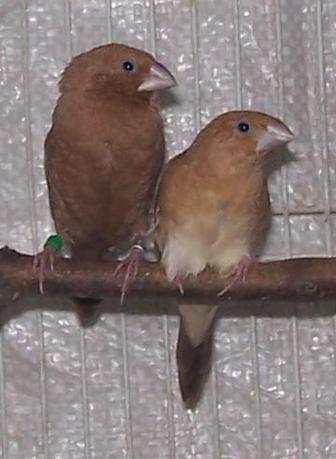African Silverbill
In early literature, African Silverbill Lonchura cantans and Indian Silverbill L. malabarica were treated as conspecific. In 1943, Jean Théodore Delacour firmly made the both species synonymous in his revision of the Estrildinae. However, in 1964, James M. Harrison first studied the two in a strictly comparative manner and concluded that they were two separate species. He discovered that although the call notes were similar, the songs are distinctly different in form, but sharing a common pattern. The are sympatric in the south of the Arabian Peninsula and there is no record of natural hybridization. From Harrison's personal observation of birds in captivity, each of the two forms evinced a preference for its own kind. In 1985, Kakizawa and Watada confirmed Harrison's conclusion. They confirmed the genetic difference of the two species by the means of protein electrophoresis. In 1990, Sibley and Monroe accept the two as distinct species.

The African Silverbill is classified as Least Concern. Does not qualify for a more at risk category. Widespread and abundant taxa are included in this category.
The African Silverbill Lonchura cantans is a small passerine bird formerly considered conspecific with the Asian species Indian Silverbill, Lonchura malabarica. This estrildid finch is a common resident breeding bird in dry savanna habitat, south of the Sahara Desert. This species is also been introduced to a few countries such as Portugal, Qatar and USA. More
The African Silverbill is approximately 10 cm in length with a long black pointed tail. The adult has a stubby silver-blue bill, finely vermiculated light-brown upper parts, whitish underparts, black rump and black wings. The sexes are similar, but immatures lack the vermiculations. This species has a tseep call and a trilling song. The contact call of the male is a single tseep while the female is a double noted tsiptsip. Birds in flight keep up a constant tseep tseep tseep. More
African Silverbill (adult)African Silverbills = Finch Information ... Finch Species ... Finch Photo Gallery ... Finch Diseases ... Finch / Canary Diet / Nutrition ... More
African SilverbillAngola CordonBengaleseBaya WeaverBicheno FinchBlackbirdBlack Breast MannikinBlackcrest FinchBlack Head CanaryBlack Headed NunBlack Head MannikinBlack Head SiskinBlack Throated CanaryBlack Throat FinchBlue Black GrassquitBlue Face Parrot FinchBroadtail ParadiseBronze Wing MannikinChaffinchCherry FinchChesnut Breast FinchCinnamon BuntingCollared DoveCommon BluefinchCommon CanaryCommon QueleaCommon WaxbillCrimson Crown BishopCrimson FinchCrimson WaxbillCrimson Wing WaxbillCuban FinchCut Throat FinchDiamond DoveDiamond SparrowDufresne WaxbillEuropean GoldfinchEuropean SerinGiant WhydahGolden SparrowGreen Front LeafbirdGreenfinchGray Head SilverbillGreen AvadavatGreen Back TwinspotGreenfinchGrenadier WeaverHalf Masked WeaverHawfinchHill MynahIndian SilverbillJava SparrowLined SeedeaterLong Tail FinchMadagascar MannikinMagpie MannikinMasked FinchMasked WeaverMelba FinchNapoleon BishopOlive FinchOrange Breasted BuntingOrange Cheeked WaxbillOriental ZosteropsOrtolan BuntingPainted QuailParadise WhydahPekin RobinPeter's Twin SpotPintail Parrot FinchPintail WhydahQuail FinchQueen WhydahRed Billed Fire FinchRed Cheek CordonRed Collar WhydahRed Cowled CardinalRed Crested CardinalRed CrossbillRed Eared BulbulRed Ear WaxbillRedhead FinchRed Head QueleaRed SiskinRedtail Lavender BirdRed Throat FinchRed Vent BulbulRufous Neck More
African Silverbill - Information - African Silverbill - Information DESCRIPTION 4l/2 inches (llcm). Sandy/taupe brown with subdued whitish stripes, darker on wings and tail, lighter on belly and undertail coverts. No visible distinction between sexes.NATURAL DISTRIBUTION West and central Africa, in four subspecies.HABITAT Savannahs, farmland and near villages, often nest under roofs, in walls of huts or in low shrubs.DIET Greens, millet and especially spray millet as a treat. More
African Silverbill populations in Australia vary widely depending upon the bird's popularity. * Temperament: Not a common bird in aviaries. Usually a prolific breeder in captivity and is suitable as a colony breeder in aviaries. * Cost (Victoria) Per Pair: - Normal colour (Approx.) $200 * Description Of Adults: Member of the Mannikin family. Genus Lonchura. More
African Silverbill, but its rump is white instead of black and it lacks the barring on its secondaries. Both the Indian and African Silverbill require similar care. The African Silverbill comes in several mutations (mostly available outside of the US), including: Chocolate (darker solid brown version of the bird), Fawn (light brown version), Red-brown or Cinnamon (a richer, brighter reddish brown version), and Ino (white). More
rump color: African silverbills have black rumps; Indian silverbills have white rumps. Pearl-headed silverbills (also called pearl-headed amadines) are a little more demanding to keep and breed, and they are visally different from their cousins. These attractive African finches have gray heads speckled with white on the face and throat, and pinkish-brown underparts. Silverbills, like many other mannikins, are difficult to sex visually; consequently, the most reliable method of sexing silverbills is listening for the song of the male. More
African Silverbill is an adaptable, easy-to-breed species. A peculiar trait of the bird includes the habit of involving themselves in incubating the eggs and other bird species and rearing the young hatched ones, which actually do not belong to them. The African Silverbill has many other advantages. It is hardy and can withstand extremes of temperature. It lives happily with other small seedeaters. There is also an Indian Silverhill (Lonchura malabarica) but the bird is not that physically hardy. More
African Silverbills (Lonchura cantans) African Silverbill African Silverbills (Lonchura cantans) African Silverbills (Lonchura cantans) African Silverbills at Ain Athoom, Taqah, Dhofar Locations for recordings with GPS coordinates page 1 African Silverbill calls? Lonchura cantans (0:11) Herman van Oosten XC44487 30-01-2010, Oman page 1 © 2005-2010 Xeno-canto Foundation. More
Family : Estrildidae
Genus : Lonchura
Species : cantans
Authority : (Gmelin, 1789)

